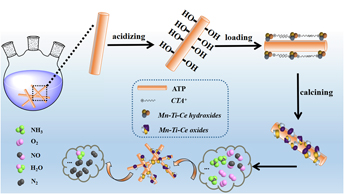Crossref Citations
This article has been cited by the following publications. This list is generated based on data provided by
Crossref.
Tang, Yiran
Tao, Yuwei
Zhou, Ting
Yang, Baozhu
Wang, Qing
Zhu, Zerui
Xie, Aijuan
Luo, Shiping
Yao, Chao
and
Li, Xiazhang
2019.
Direct Z-scheme La1-xCexMnO3 catalyst for photothermal degradation of toluene.
Environmental Science and Pollution Research,
Vol. 26,
Issue. 36,
p.
36832.
Xie, Aijuan
Tang, Yiran
Huang, Xiaoyan
Jin, Xiang
Gu, Pengfei
Luo, Shiping
Yao, Chao
and
Li, Xiazhang
2019.
Three-dimensional nanoflower MnCrO /Sepiolite catalyst with increased SO2 resistance for NH3-SCR at low temperature.
Chemical Engineering Journal,
Vol. 370,
Issue. ,
p.
897.
Charisiou, Nikolaos D.
Sebastian, Victor
Hinder, Steven J.
Baker, Mark A.
Polychronopoulou, Kyriaki
and
Goula, Maria A.
2019.
Ni Catalysts Based on Attapulgite for Hydrogen Production through the Glycerol Steam Reforming Reaction.
Catalysts,
Vol. 9,
Issue. 8,
p.
650.
Tang, Yiran
Tao, Yiyang
Wu, Jiayi
Xu, Linjing
Huang, Xiaoyan
Zhou, Xingmeng
Xie, Aijuan
Luo, Shiping
Yao, Chao
and
Li, Xiazhang
2019.
MnFeTiOx/attapulgite catalysts with excellent potassium resistance for SCR of NOx with NH3 at low temperatures.
Journal of Materials Research,
Vol. 34,
Issue. 07,
p.
1188.
Xie, Wangwang
Zhang, Guodong
Mu, Bin
Tang, Zhicheng
and
Zhang, Jiyi
2020.
The promoting effect of palygorskite on CeO2-WO3-TiO2 catalyst for the selective catalytic reduction of NOx with NH3.
Applied Clay Science,
Vol. 192,
Issue. ,
p.
105641.
Xiong, Zhi-bo
Qu, Xiao-ke
Du, Yan-ping
Li, Cheng-xu
Liu, Jing
Lu, Wei
and
Wu, Shui-mu
2020.
Selective catalytic reduction of NOx with NH3 over cerium–tungsten–titanium mixed oxide catalyst: Synergistic promotional effect of H2O2 and Ce4+.
Journal of Materials Research,
Vol. 35,
Issue. 16,
p.
2218.
Xie, Aijuan
Wang, Haoye
Qi, Songya
Li, Xiang
Zhu, Zerui
Zhang, Wanqi
Wang, Qing
Tang, Yiran
and
Luo, Shiping
2021.
Mesoporous SmMnO3/CuMnO catalyst for photothermal synergistic degradation of gaseous toluene.
Ceramics International,
Vol. 47,
Issue. 22,
p.
31485.
zhang, xianlong
Hu, Xiaorui
Liu, shiwen
Jin, Shi
Wang, xinyu
Chen, Yazhong
Wang, Junwei
Xiao, Kesong
and
Wu, xueping
2021.
MnO <sub>x</sub>-Pillared Rectorite Prepared by in Situ Deposition as Efficient Catalysts for Low Temperature NH <sub>3</sub>-SCR: The Influence of Precursors.
SSRN Electronic Journal ,
Xie, Wangwang
Zhang, Guodong
Mu, Bin
Tang, Zhicheng
and
Zhang, Jiyi
2021.
The Effects of Surface Modification of ATP on the Performance of CeO2–WO3/TiO2 Catalyst for the Selective Catalytic Reduction of NOx with NH3.
Catalysis Surveys from Asia,
Vol. 25,
Issue. 3,
p.
301.
Mytareva, A. I.
Bokarev, D. A.
and
Stakheev, A. Yu.
2021.
Seven Modern Trends in the DeNOx Catalyst Development.
Kinetics and Catalysis,
Vol. 62,
Issue. 1,
p.
1.
Chen, Jisai
Xu, Mutao
Jin, Qijie
Zhi, Xiaohuan
Chen, Yingwen
Li, Xue
Lu, Yao
Wang, Yan
and
Xu, Haitao
2022.
Simultaneous catalytic removal of NO and chlorobenzene over Sn–Mn–Ce–Co–Ox double-way catalyst.
Journal of Materials Research,
Vol. 37,
Issue. 7,
p.
1390.
Zhang, Xianlong
Hu, Xiaorui
Liu, Shiwen
Chen, Yazhong
Jin, Shi
Wang, Xinyu
Wang, Junwei
Xiao, Kesong
and
Wu, Xueping
2022.
MnO -pillared rectorite prepared by in situ deposition as efficient catalysts for low-temperature NH3-SCR: The influences of manganese (II) precursors.
Journal of Environmental Chemical Engineering,
Vol. 10,
Issue. 2,
p.
107318.
Xiong, Zhi-bo
Guo, Fu-cheng
Zhang, Jia-xin
Lu, Wei
and
Shi, Huan-cong
2022.
Influence of g-C3N4 doping on the NH3-SCR activity of Cerium–tungsten–titanium mixed oxide catalyst.
Journal of Materials Research,
Vol. 37,
Issue. 3,
p.
835.
Zhang, Lixing
Liang, Lisi
Ma, Hongyue
Mi, Han
Zhang, Ziheng
Li, Yi
Xu, Qiang
Zhao, Chen
Chen, Jin
Qiao, Jiangyu
and
Cui, Zhongyi
2024.
Study on the Effect of Fe Doping on SCR Activity and Reaction Mechanism of Mn–TiO2 Catalysts.
Catalysis Letters,
Vol. 154,
Issue. 6,
p.
2777.
Xiong, Zhibo
Zhang, Jing
Guo, Fucheng
Zhou, Fei
Yang, Qiguo
Lu, Wei
and
Shi, Huancong
2024.
Optimizing study on the NH
3
-SCR activity of Ce-W-Ti@g-C
3
N
4
catalyst: influence of graphite carbon nitride types
.
Environmental Technology,
Vol. 45,
Issue. 22,
p.
4512.


